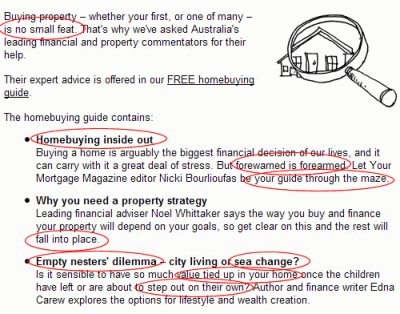Content still king? Not in WCAG 2.0
The new accessibility guidelines are disappointing. They do little to foster quality content. They seem weaker on content standards than the earlier version.
Writing readable content now seems optional
In version 1.0 of the guidelines, writers were urged to 'Use the clearest and simplest language appropriate for a site's content'
. As a priority 1 (or level A) requirement, this was mandatory.
Version 2.0 says: 'When text requires reading ability more advanced than the lower secondary education level after removal of proper names and titles, supplemental content, or a version that does not require reading ability more advanced than the lower secondary education level, is available.'
While this spells out a standard, the new guideline is relegated to the lowest priority (known as level AAA). At this level, guidelines are 'not recommended ... as a general policy for entire sites'
. In effect, this makes it optional to write readable content!
Organising content with headings is also optional
Version 2.0 of the guidelines say 'Section headings are used to organise the content'
. In version 1.0, using headings was a medium priority (level AA). In the new guidelines it has been given the lowest priority (level AAA). Using headings is now optional.
It's now OK to write poor link text
The old guidelines said 'Clearly identify the target of each link'
, and this was a medium priority (level AA).
There are now two guidelines for links. The stronger one that requires clear link text is now the lowest priority, level AAA. The weaker one, allowing links such as 'read more' and 'click here', is a stronger priority. Again, the new guidelines seem to lower the standard for good writing.
Workarounds aren't great solutions
The new guidelines tell writers to define 'words or phrases used in an unusual or restricted way, including idioms and jargon'.
This is a new guideline, and drawing these things to a writer's attention is a good thing. However, suggesting a definition as a solution is really just a workaround. Let's look at an example.
An old page from the Westpac website (shown below, with full text on the Internet Archive) is full of idioms.

Researchers in Italy recently tested this kind of language on a group of students. They found that the students took longer to understand idioms than literal language. Cutting back on them, rather than adding definitions, will benefit everyone.
Ah, but I forgot to mention this guideline is only a suggestion. At level AAA, it's optional. So you won't need to address the problem at all if you don't want to.
Writers need to aim higher
To produce good, accessible content, writers will need to do more than the new guidelines suggest. If content is to be king, we'll all have to aim higher.
References
Web writing course
Learn how to write and design content that's easy to find, read, and use.
We run live online training for individuals and groups.
Book a course at https://4syllables.com.au/